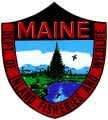The Maine Butterfly Survey Takes Flight for a Sixth Season
OutdoorHub 05.14.12

With at least 120 species, butterflies contribute a colorful component to Maine’s biological diversity. In addition to serving as delicate harbingers of spring, butterflies also play important ecological roles, both as pollinators of wildflowers and as prey to larger species, from dragonflies to migrant birds. Butterflies are also valuable ecological indicators of ecosystem stress due to habitat loss, pollution, and climate change. Their economic contribution in terms of “watchable wildlife” is difficult to estimate, but clearly no other group of insects has attracted as much attention from naturalists and eco-tourists, a group whose ranks increasingly include bird watchers armed with close-focusing binoculars.
Many neighboring states and provinces, including Vermont, Connecticut, Massachusetts, and New Brunswick, have compiled atlases of their butterfly fauna. Despite growing concern for pollinating insects generally and butterflies specifically, Maine had only a rudimentary knowledge of the group, until now.
Initiated in 2007, the Maine Butterfly Survey (MBS) is a statewide, volunteer survey effort designed to fill information gaps on butterfly distribution, flight seasons, and habitat relationships for one of the state’s most popular insects. Following in the tradition of previously state-sponsored wildlife surveys, such as the Maine Amphibian and Reptile Atlas Project, data generated from the MBS comes primarily from trained citizen scientists.
There is an increasing demand for information on the health and status of butterflies and other wildlife in Maine. MDIFW receives requests for data on butterflies from landowners, land trusts, outdoor organizations, and scientists. Of special note is the high proportion of state butterflies (~20%) considered Extinct, Endangered, Threatened, or Special Concern — a result consistent with global trends elsewhere for the group. Greater statewide butterfly survey effort could demonstrate that some species are more abundant than formerly believed, while others may merit increased conservation attention. By marshalling the efforts of professional and citizen scientists from across Maine, this multi-year statewide butterfly atlas is designed to provide MDIFW and its conservation partners with a significant increase in knowledge on the status of the state’s butterfly fauna.
To help new volunteers join the survey MDIFW is sponsoring a six-hour training workshop in June (on a Saturday to be determined) at Colby College in Waterville. Participants will learn about butterfly biology, identification, and details on MBS survey protocols. Lunch will be provided and participants will be given a butterfly net, collecting equipment, and training manual. To become involved in this project or to learn more about Maine’s butterflies contact the MDIFW coordinator, Phillip deMaynadier, at phillip.demaynadier@maine.gov or the MBS volunteer coordinator, Dr. Herb Wilson, at whwilson@colby.edu. Also check details on progress to date at the MBS website: http://mbs.umf.maine.edu.

